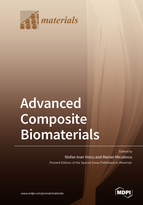Advanced Composite Biomaterials
A special issue of Materials (ISSN 1996-1944). This special issue belongs to the section "Biomaterials".
Deadline for manuscript submissions: closed (30 November 2020) | Viewed by 40738
Special Issue Editors
2. Department of Analytical Chemistry and Environmental Engineering, Faculty of Chemistry and Materials Science, University Politehnica of Bucharest, 011061 Bucharest, Romania
Interests: synthesis and characterisation of polymeric membranes; biomedical applications of polymeric membranes; functionalization and derivatization of carbon-based nanospecies
Special Issues, Collections and Topics in MDPI journals
Interests: thermal properties; mechanical properties; composites; materials characterization; microscopy
Special Issue Information
Dear Colleagues,
In recent years, there has been an increasing interest in biomedical engineering, which has to respond to more and more challenges, in particular related to changes in lifestyle and environmental factors. If two or three decades ago this domain was limited to a small number of applications, there are now a number of niche domains such as tissue engineering, polymeric materials for osteointegration, artificial organs, devices for the controlled release of drugs and the new materials must respond to all the challenges that have arisen. Among the new synthesized materials, one can distinguish the composites with carbon or graphite nanotubes, the filler having both the role of refining and improvement of some properties such as conductivity, adsorption or release of various substances capacities. The present Special Issue is dedicated to composite biomaterials with carbon nanotubes or graphene applicable in tissue engineering, osteointegration etc. The domains addressed by this issue are:
- Polymer-carbon nanotube composite biomaterials;
- Polymer-graphene composite biomaterials;
- Ceramic-carbon nanotubes composite biomaterials;
- Applications of carbon-nanotube composite biomaterials;
- Applications of graphene composite biomaterials;
- Characterization methods for carbon nanotube composite biomaterials;
- Characterization methods for graphene composite biomaterials.
Prof. Stefan Ioan Voicu
Prof. Marian Miculescu
Guest Editors
Manuscript Submission Information
Manuscripts should be submitted online at www.mdpi.com by registering and logging in to this website. Once you are registered, click here to go to the submission form. Manuscripts can be submitted until the deadline. All submissions that pass pre-check are peer-reviewed. Accepted papers will be published continuously in the journal (as soon as accepted) and will be listed together on the special issue website. Research articles, review articles as well as short communications are invited. For planned papers, a title and short abstract (about 100 words) can be sent to the Editorial Office for announcement on this website.
Submitted manuscripts should not have been published previously, nor be under consideration for publication elsewhere (except conference proceedings papers). All manuscripts are thoroughly refereed through a single-blind peer-review process. A guide for authors and other relevant information for submission of manuscripts is available on the Instructions for Authors page. Materials is an international peer-reviewed open access semimonthly journal published by MDPI.
Please visit the Instructions for Authors page before submitting a manuscript. The Article Processing Charge (APC) for publication in this open access journal is 2600 CHF (Swiss Francs). Submitted papers should be well formatted and use good English. Authors may use MDPI's English editing service prior to publication or during author revisions.
Keywords
- Composite biomaterials
- Carbon nanotube
- Graphene
- Characterization methods
- Polymer-carbon nanotube composites
- Polymer-graphene composites
- Biomaterials








